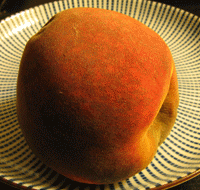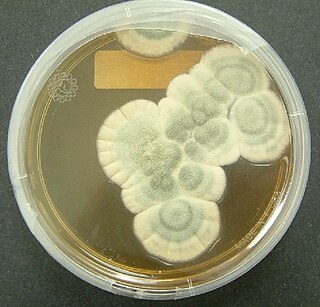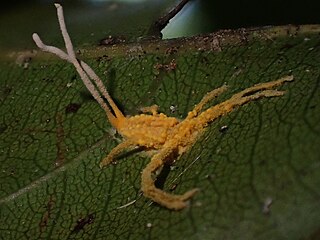
A mold or mould is one of the structures that certain fungi can form. The dust-like, colored appearance of molds is due to the formation of spores containing fungal secondary metabolites. The spores are the dispersal units of the fungi. Not all fungi form molds. Some fungi form mushrooms; others grow as single cells and are called microfungi.

Penicillium is a genus of ascomycetous fungi that is part of the mycobiome of many species and is of major importance in the natural environment, in food spoilage, and in food and drug production.

Malassezia is a genus of fungi.

Eurotiomycetes is a large class of ascomycetes with cleistothecial ascocarps within the subphylum Pezizomycotina, currently containing around 3810 species according to the Catalogue of Life. It is the third largest lichenized class, with more than 1200 lichen species that are mostly bitunicate in the formation of asci. It contains most of the fungi previously known morphologically as "Plectomycetes".

Penicillium roqueforti is a common saprotrophic fungus in the genus Penicillium. Widespread in nature, it can be isolated from soil, decaying organic matter, and plants.
Microfungi or micromycetes are fungi—eukaryotic organisms such as molds, mildews and rusts—which have microscopic spore-producing structures. They exhibit tube tip-growth and have cell walls composed of chitin, a polymer of N-acetylglucosamine. Microfungi are a paraphyletic group, distinguished from macrofungi only by the absence of a large, multicellular fruiting body. They are ubiquitous in all terrestrial and freshwater and marine environments, and grow in plants, soil, water, insects, cattle rumens, hair, and skin. Most of the fungal body consists of microscopic threads, called hyphae, extending through the substrate in which it grows. The mycelia of microfungi produce spores that are carried by the air, spreading the fungus.

Penicillium chrysogenum is a species of fungus in the genus Penicillium. It is common in temperate and subtropical regions and can be found on salted food products, but it is mostly found in indoor environments, especially in damp or water-damaged buildings. It has been recognised as a species complex that includes P. notatum, P. meleagrinum, and P. cyaneofulvum. Molecular phylogeny has established that Alexander Fleming's first discovered penicillin producing strain is of a distinct species, P. rubens, and not of P. notatum. It has rarely been reported as a cause of human disease. It is the source of several β-lactam antibiotics, most significantly penicillin. Other secondary metabolites of P. chrysogenum include roquefortine C, meleagrin, chrysogine, 6-MSA YWA1/melanin, andrastatin A, fungisporin, secalonic acids, sorbicillin, and PR-toxin.

Charles Thom was an American microbiologist and mycologist. Born and raised in Illinois, he received his PhD from the University of Missouri, the first such degree awarded by that institution. He studied the microbiology of dairy products and soil fungi, and in particular researched the genera Aspergillus and Penicillium. His work influenced the establishment of standards for food handling and processing in the USA. He pioneered the use of culture media to grow microorganisms, and, with food chemist James N. Currie, developed a process to mass-produce citric acid using Aspergillus. Thom played an important role in the development of penicillin in World War II.

Penicillium rubens is a species of fungus in the genus Penicillium and was the first species known to produce the antibiotic penicillin. It was first described by Philibert Melchior Joseph Ehi Biourge in 1923. For the discovery of penicillin from this species Alexander Fleming shared the Nobel Prize in Physiology or Medicine in 1945. The original penicillin-producing type has been variously identified as Penicillium rubrum, P. notatum, and P. chrysogenum among others, but genomic comparison and phylogenetic analysis in 2011 resolved that it is P. rubens. It is the best source of penicillins and produces benzylpenicillin (G), phenoxymethylpenicillin (V) and octanoylpenicillin (K). It also produces other important bioactive compounds such as andrastin, chrysogine, fungisporin, roquefortine, and sorbicillins.
Penicillium allii-sativi is a fungus species of the genus Penicillium, section Chrysogena. It is one of several Penicillium species that can produce penicillin in culture. The fungus has been found in Argentina, Bulgaria, France, Portugal, South Africa, and the United Kingdom. The specific epithet allii-sativi refers to the garlic plant, Allium sativum, from which the fungus was isolated.
Penicillium alexiae is a fungus species of the genus of Penicillium. Penicillium alexiae is named after Princess Alexia of the Netherlands.
Penicillium amaliae is a fungus species of the genus of Penicillium. Penicillium amaliae is named after Catharina-Amalia Beatrix Carmen Victoria.
Penicillium vanoranjei is an orange-colored fungus first described in 2013 from specimens collected in Tunisia. It was named after the Prince of Orange Willem-Alexander to commemorate his coronation as King of the Netherlands.
Penicillium arianeae is a fungus species of the genus of Penicillium which is named after Princess Ariane of the Netherlands.

Engyodontium is a genus of fungi belonging to the group Hyphomycetes and contains about 6 species. This fungus was formerly included in Beauveria, but is now recognized as a distinct genus.
Penicillium palmae is a fungus species of the genus Penicillium.
Penicillium scabrosum is a species of fungus in the genus Penicillium. Described as new to science in 1990, it was first isolated from soil associated with corn in Denmark. It has also been found in soil samples from other temperate areas of the world, including Canada. The fungus is a spoilage organism for foods, particularly those with lipid- and cereal-containing feed. It produces several mycotoxins, including fumagillin, viridicatin, and viridicatol. P. scabrosum is classified in Penicillium subgenus Penicillium, section Divaricatum, series Atroveneta.
Penicillium tardochrysogenum is a filamentous species of fungus in the genus Penicillium which produces penicillin, secalonic acids D and secalonic acids F.
Penicillium commune is an indoor fungus belonging to the genus Penicillium. It is known as one of the most common fungi spoilage moulds on cheese. It also grows on and spoils other foods such as meat products and fat-containing products like nuts and margarine. Cyclopiazonic acid and regulovasine A and B are the most important mycotoxins produced by P. commune. The fungus is the only known species to be able to produce both penitrem A and roquefortine. Although this species does not produce penicillin, it has shown to have anti-pathogenic activity. There are no known plant, animal or human diseases caused by P. commune.

Acremonium isabellae is a species of fungus in the genus Acremonium. It was discovered at Rowlands Creek near Uki in NE New South Wales in 2023 on the body of a dead spider being consumed by an entomopathogenic fungi. Citizen scientist Isabella Teal discovered the fungus while collecting samples of spider-eating fungi with her father and it was subsequently named after her. It was first described along with other microfungi in the 11 September 2023, Index of Australian Fungi. The sample this fungi was identified on, can be seen arriving at the lab in the upcoming documentary Follow the Rain.









